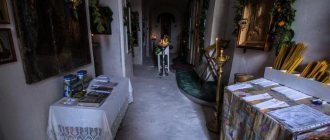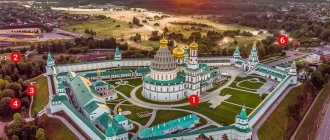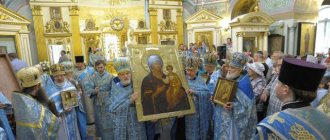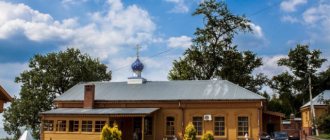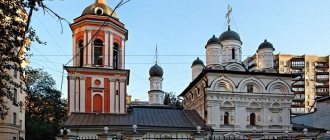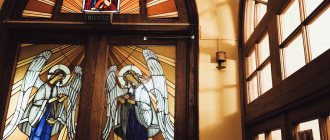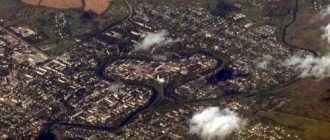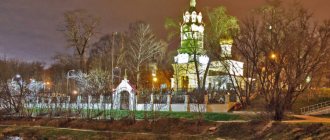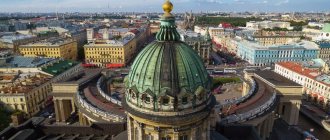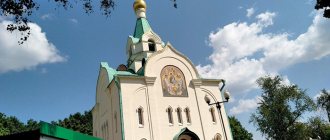I want to share with you a story about a wonderful place in St. Petersburg - the Resurrection Novodevichy Convent.
All of us, visiting new cities (towns and villages) on our travels, strive to see their “attractions”, places “worthy of note” that evoke a heartfelt response from us. When talking about churches and monasteries that preserve the sacred spirit of the locality where they are located, I immediately remember the words of Plato: “Beauty is the convincing power of truth.”
When you find yourself in the peaceful silence of a church, you suddenly begin to clearly hear the voice of your own heart. So I invite you to enjoy a similar encounter with the spiritual beauty of life by visiting the Novodevichy Convent in St. Petersburg.
How to get there
Getting here is quite easy. We get off at the Moskovskie Vorota metro station (1) , cross Moskovsky Prospekt and move towards the Obvodny Canal (if you stand with your back to the metro, then to the left). Monastery address: Moskovsky Ave. 100
You will pass the chapel of Equal-to-the-Apostles Nina and St. Sergius of Radonezh (2) , which belongs to the monastery, a gas station and will soon walk along a high fence. We enter the gate with a barrier (3) (entrance is free, only women need to put on a headscarf) and find ourselves on the territory of the monastery. If you come by car, you can park for free right on the side of the road opposite the monastery.
Monastery bell tower
In 1895, a grandiose four-tiered monastery bell tower was erected next to the Resurrection Cathedral. It resembled the Bell Tower of Ivan the Great in the Moscow Kremlin. The first tier contained the main arched entrance to the monastery. In the second tier there was the gate church of St. Isidore Pelusiot, the heavenly patron of Metropolitan Isidore who died three years earlier. There were belfries in the two upper tiers of the bell tower. As on the drums of the cathedral domes, both upper tiers were surrounded by an arcade, in every second arch of which there was an opening. The bell tower was crowned with a voluminous onion dome.
The bell tower was blown up in the late 1920s due to the expansion of Moskovsky Avenue.
History of the Resurrection Novodevichy Convent
The appearance of a convent in St. Petersburg
At first, the convent, founded in St. Petersburg in 1748, was located on the site of the Smolny Palace and was called the Resurrection Maiden Smolny Convent, but due to various circumstances it was abolished in 1797.
Thus, in the middle of the 19th century there were no convents for women in the capital. At this time, Emperor Nicholas I supported the initiative of the Chief Prosecutor of the Holy Synod, Count N.A. Protasov, to revive the Resurrection Monastery. It was placed on Vasilievsky Island, and in 1848 it was moved to the Moscow Outpost area.
The first abbess becomes nun Feofaniya (Gotovtseva), summoned to the capital from the Goritsky monastery. Even in her youth, she heard the prophecy of her confessor, Archimandrite Theophan, about the future glory of the St. Petersburg monastery long before its appearance. First, a wooden church is built in the monastery in honor of the Kazan Icon of the Mother of God. On November 3 (15), 1849, in the presence of Emperor Nicholas I, the ceremonial laying of the Resurrection Cathedral takes place.
In 1854, the nuns moved into the newly built cell buildings, and the church was illuminated in honor of the “Consolation and Consolation” icon.
A list of the miraculous Icon of the same name from the Greek Athos was placed here. This gift was sent to the convent of St. Petersburg by Elder Seraphim of Svyatogorets. In 1855, the consecration of the temple took place in honor of Basil the Great, Gregory the Theologian and John Chrysostom. In 1861, construction of the majestic Resurrection Cathedral with five chapels was completed. Before the revolution, there were amazing shrines here, including the icon of the Resurrection of Christ with a piece of the Holy Sepulcher, the family icon of the Ushakovs (Kazan Mother of God), the Image of the Savior Not Made by Hands (16th century), belonging to Ivan the Terrible.
In 1866, the earthly journey of the first abbess of the monastery, Mother Feofania, ended. She was buried behind the altar of the Resurrection Cathedral. Today her honorable remains were transferred to the Kazan Church.
All subsequent abbess also played a major role in the flourishing of the monastery. In 1895, a golden-domed bell tower was erected (designed by L.I. Benois and Zeiler). Hermitages and farmsteads appear at the monastery.
By 1901, buildings for the refectory, sacristy, library and hospital appeared. I would like to note that the monastery, in addition to prayer, was diligently engaged in social service. An orphanage, an almshouse, a school, and an archive operated on its territory. From 1908 to 1912, a stone Kazan church was built in the Byzantine style (design by V. A. Kosyakov). But she was never consecrated.
By 1917, 400 nuns lived in the monastery: nuns, workers, sisters preparing for tonsure. There were 8 temples on the territory. There was a large, well-established farm: farms, an apiary, a stable, and a poultry house. There were a lot of famous workshops throughout Russia, an almshouse, an orphanage and a hospital.
Novodevichy Necropolis
My story about the monastery will not be complete without a story about the Novodevichy cemetery, located in its eastern part, where there were two monastery churches - Skorbyashchenskaya (1855, designed by E.I. Zhiber) and Ilyinskaya (1983, architect L. N. Benoit). Since 1848, many famous people have been buried here, whose names are inextricably linked with state and military history, as well as with the culture and education of Russia.
Among them are N.A. Nekrasov, F.I. Tyutchev, S.P. Botkin, D.O. Ott, M.A. Vrubel... In Rus', cemeteries have always been considered “God’s field”, where the seeds for eternal life are sown.
My mother told me how an old professor once told them at a lecture at a medical institute: “When you are incredibly happy or very sad, go to the cemetery. There peace in the soul will be restored." And this has a deep meaning. Cemeteries preserve historical memory. It is not without reason that all nations always have a reverent attitude towards them. From 1849 to 1934 About 26,000 people were buried at the Novodevichy cemetery. The names of nobles, representatives of noble merchants, artists and scientists are carved on the gravestones.
The place to the left of the entrance was reserved for the burial of the nuns of the monastery. It is here that a lot of people come today to honor the memory of Elder Daryushka the Wanderer, whom I will certainly tell you about later.
Before the revolution of 1917, excellent care was organized for the Novodevichy cemetery. The paths were regularly cleared, the lawns and flower beds were kept in perfect condition. The monuments were executed by famous masters, including V. M. Vasnetsov, P. K. Klodt, N. A. Roerich. The crypts were decorated with icons, silver wreaths, and lamps.
Unfortunately, most of the burials have not survived, but even today the surviving granite and marble monuments with forged fences amaze with their grandeur.
If you leisurely walk along the paths of the cemetery, reading the names and epitaphs, you notice that, in fact, according to that same professor, your mental balance is restored, your problems seem absurd and small, and life takes on greater value.
Statue of Christ on the grave of Anna Vershinina
I want to tell you more about one burial place, near which there are fresh flowers and burning candles at any time of the year. This is a tombstone over the grave of Anna Vershinina with a sculptural Image of Christ standing near a majestic granite cross (1915, author P.I. Kufferle).
It is also called an “open-air temple.” People come here from everywhere. Once I happened to hear the words of one grandmother: “You, St. Petersburg residents, always go somewhere to holy places, but you yourself have such a place here, on Novodevichy.”
According to legend, the general couple Vershinins had no children. Anna Akimovna was very worried that after her death there would be no one to care for the grave. But her husband decorated the place of her burial in such a way that even today the flow of people coming here does not dry out. If you approach this sculpture, you will see that the sculpture of Christ has no feet. They were cut off by looters who wanted to steal the bronze statue (for which they later paid cruelly, as eyewitnesses said, with similar mutilation). The miracle is that this monument survived. Notes with requests for everyday and spiritual needs are always left here. These days the tombstone is kept in perfect order.
Architecture
The creator of the project for all the main monastery buildings was the famous architect N. Efimov. In the center of the architectural composition of the monastery ensemble is the Resurrection Cathedral.
The appearance of the cathedral resembles Suzdal churches of the 15th century, while the height is about 50 meters
The buildings of the sister cells are arranged in the shape of the letter U and are interrupted by two house churches with small domes and hipped bell towers
The Kazan Church was built in 1910 according to the design of the architect V. A. Kosyakov . The structure was supposed to reflect the centuries-old history of Christianity, combining Russian and Byzantine culture.
During the Soviet years, the Temple of Our Lady of Kazan was used as a mechanical workshop at the All-Russian Research Institute of Electrical Mechanical Engineering
Interior decoration
The walls, vault and images of the Resurrection Cathedral were painted by monastery painters and nuns. Unfortunately, the interior of the temple has not been preserved even in sketches and photographs. The interior decoration of the cathedral was created anew; ancient Russian samples were taken as the basis for the painting.
Only fragments of decorative painting of the Resurrection Cathedral related to the renovation of 1914–1916, in the vaults of the southern and western galleries of the cathedral, have survived to this day.
The inside of the Kazan Church is richly decorated with gold stucco and paintings. The paintings were made in the Russian style by the artist F. Railyan, and for the most part have survived to this day. The central hall is designed in the form of a rotunda, surrounded by red marble columns.
Exterior decoration
The Cathedral of the Resurrection of Christ is a monumental building in the Byzantine-Russian style. The five-domed cathedral has five chapels, crowned with a large golden dome and four small ones. Bell towers are located in small domes.
The facades of the Church of the Resurrection are decorated with decorative arcades. The domes of the Kazan Church are located on low drums, also surrounded by an arcade.
The five-domed Kazan Church is an example of the Byzantine style. Initially, the domes were covered with special tiles, which were replaced with copper sheets during restoration. The portals in which the entrances are located are formed by vaults decorated with carvings. The elegant decoration of the facades and portals contains Christian symbols. The temple is lined with white brick and resembles the St. Sophia Cathedral in Constantinople .
Monastery in Soviet times
During the years of fighting against God, the Resurrection Novodevichy Convent drank the cup of sorrow in full. Magnificent churches and chapels were closed, destroyed, and dismantled brick by brick.
Arrests and executions followed. On May 31, 1932, it was decided to liquidate the Resurrection Cathedral and transfer the “building” for the establishment of... a department store. In 1933, the magnificent bell tower with the Church of Isidore Pelusiot located in it was blown up. The fact is that the belfry, according to the authorities, interfered with the “straight path” of the Moscow highway. But what it would actually look like now can be seen thanks to the photo depicting the project for its reconstruction.
The Novodevichy cemetery was also desecrated.
The spiritual life of the monastery thus froze in 1937. The unique church-architectural ensemble was mutilated beyond recognition, and its interior was given over to the needs of the Electrical Mechanical Engineering Research Institute. But it was precisely that tragic period that, according to church historian A.E. Krasnov-Levitin, became “the greatest flowering of St. Petersburg monasticism,” which in the first years of Soviet power was distinguished by unprecedented spiritual strength and purity.
Until its complete closure, the Novodevichy Convent served as the residence for the Leningrad metropolitans: Seraphim (Chichagov) and Alexy (Simansky). As for the unique Novodevichy Necropolis, in the Soviet years it resembled a barbaric quarry, where the most valuable tombstones were dismantled and stolen, chapels and churches were destroyed.
In 1933 the cemetery was closed. Monuments of many famous people (for example, composer N. A. Rimsky-Korsakov and architect L. N. Benois) were moved to other places. Since 1960, under the pretext of eliminating “orphans,” 400 tombstones have been destroyed. It’s creepy for me to read such facts, but they help me appreciate more what was miraculously preserved.
Renaissance
Restoration of the monastery
The revival of the monastery began in 1996. And it seems absurd that at the end of the 20th century in the center of St. Petersburg, the sister community initially had to huddle in a room without heating, water supply or sewerage. But despite all the everyday difficulties, the monastery came to life. Temples and buildings were gradually returned to him. True, they all required major repairs.
The work to revive the monastery was more than once accompanied by miracles. Thus, on November 6, 1996, the icon of the Kazan Mother of God was renewed without any restoration. A case that cannot be explained by physical laws. The discovery of the grave of the first abbess Feofaniya is also considered a miracle. During Soviet times, it was desecrated and was under asphalt.
By 2002, all buildings were returned to the monastery. This “island of eternity” has come to life again among the bustle of St. Petersburg. Today the Kazan, Athos and Vvedensky churches have been renovated. A chapel was built in the name of Sergius of Radonezh and St. Nina, Equal to the Apostles, which you passed by on your way to the monastery from the metro.
The Resurrection Cathedral is being revived. The monastery houses an almshouse, an orphanage, a Sunday school, sewing workshops, a shelter for young mothers with children in crisis, its own publishing house and a pilgrimage house.
I would also like to note the existence of a medical charity that deals with the diagnosis of female oncology.
There is a wonderful church shop for guests of the monastery. In my opinion, she is one of the best in St. Petersburg. When people first come here, they often note that it already resembles a museum in itself. Nowadays, the Novodevichy Resurrection Monastery is a place where great shrines are often brought.
And people stand for long hours, even in bad weather, just to touch them for a moment. All this testifies to the revival of the spirituality of our country. I also visit the monastery during such events and see for myself that it is no longer grandmothers in headscarves, but people of all ages, young and old, who flock to the monastery like a river.
I think everyone remembers the time when the Belt of the Virgin Mary or the Gifts of the Magi were brought to Russia from Athos. In St. Petersburg, they were located for worship in the Novodevichy Convent.
You can read about when other great shrines will arrive at the monastery on the official website. Upon the arrival of the right hand of St. Spyridon of Trimifuntsky, who in Rus' was previously revered in the same way as St. Nicholas the Wonderworker, an amazing event happened here. When we arrived at the monastery, there was no queue at all! But all day long people stood in front of this for many hours! We bowed to the Saint, and the line began to grow again. And you felt so joyful, as if for some reason you had been undeservedly caressed by a heavenly saint.
Revival of the Necropolis
The thaw of times also affected the long-suffering Novodevichy Necropolis. In 1995 it became a monument of federal significance.
Order has also been restored here, many graves have been decorated, and burials continue. It’s good to come here in winter, when tar crows walk through the snow like strict guards, and the naked branches of trees against the backdrop of the St. Petersburg sky seem especially touching.
I love this Necropolis even in autumn, an amazingly beautiful and at the same time sad time of farewell to golden leaf fall and warmth. According to Saint Ignatius (Brianchaninov), trees remind us of eternity, that after the winter of life the spring resurrection will certainly come.
Monastery today
Architectural ensemble
You can learn in detail about the architecture of the currently operating and not yet restored churches of the Resurrection Novodevichy Convent, as well as the stories associated with them here.
I would like to mention separately the new house church in the name of St. Seraphim of Vyritsky, located in the Igumensky building. On November 26, 1012, it was consecrated, and the first liturgy was celebrated here. The painting inside the temple was done by icon painters of the monastery workshop - E. Ivanova and A. Syslova. The fact is that the name of the famous St. Petersburg saint, one might say, our contemporary, is closely connected with the Novodevichy Convent.
By the way, on August 10, 2021, the church ensemble of the monastery was replenished again.
At Pulkovo Airport, a chapel of the icon of the Mother of God “Blessed Sky” was opened, belonging to the Novodevichy Resurrection Convent.
Shrines of the monastery
All visitors to the monastery, if desired, can venerate its amazing shrines. A detailed account of them and the miracles associated with them can be found here.
But I want to add one more icon to this list - “Consolation and Consolation”. It was written on Holy Mount Athos and transferred to the monastery in 2003. This large icon stands on the right side of the Kazan Church. One day, an elderly woman stopped me and my friend near her and reminded us that the celebration of this Image takes place on February 3, when a special night service even takes place in the church in honor of Him.
And so she spoke soulfully about this icon that already six months later, on February 3, my not very church-going friend called me and reminded me that today is the Day of the Vatopedi Icon of the Mother of God! By the way, in the same Kazan temple there is also the Image of the Last Judgment, donated to the monastery by President V.V. Putin.
Devotees of the monastery
You can learn about wonderful people whose destinies were closely intertwined with the monastery here. By the way, some of them are canonized today.
In addition, I want to talk a little about two of them.
Wanderer Daryushka
In 2007, I myself first learned about Daryushka, who is called the wanderer because she visited many churches in Russia on foot, including Solovki and the Kyiv Lavra. Today, for the canonization of this ascetic, materials are being collected about numerous miracles that occur when seeking her prayerful help. Before her death at the age of 80, Daryushka took monastic vows in the name of the 4th century holy fool Isidora (May 10/23). On July 14, 1854, the monastery saw her off on her last journey with great honors. In memory of the newly deceased Elder Isidora, they held a memorial meal, at which they fed and gave money to the poor and wretched, dear to the merciful heart of the deceased. Her grave is located near the entrance to the Novodevichy cemetery.
The pilgrims come here, leave notes with requests, read “Rejoice to the Virgin Mary!” three times, and prayerfully remember the soul of the deceased ascetic. This woman had the custom of always thanking God for everything, despite all the difficulties of fate. She called herself nothing more than a “thin man”, “a poor nature”, in which humble foolishness is visible, a deep stamp of Russian holiness. She brought joy and comfort to all people. I highly recommend purchasing from the monastery shop a narrative about her life written by S. I. Snessoreva. The book is compiled from Daryushka’s personal stories and conveys the lively, ingenuous speech of the ascetic herself, filled with love for God and neighbor.
Spiritual writer S. I. Snessoreva
I would like to tell you about Sofia Ivanovna Snessoreva herself, a wonderful writer, whose name is undeservedly forgotten today. Her fate is closely connected with the Resurrection Novodevichy Convent. By the way, we should be grateful to her for the translations of “Folk Tales of the Brothers Grimm.” Sofia Ivanovna was the spiritual daughter of Saint Ignatius (Brianchaninov), whose works (5 volumes) she corrected and edited at his request, and also after the death of the Saint she wrote a short essay about him.
After working on a book about Daryushka the Wanderer, the writer spent 2 years working on a biography of the first abbess of the monastery, Feofania (1868). Next, she devoted 5 years to the history of the monastery itself. The book by S. I. Snessoreva “The St. Petersburg First-Class Convent” (1887) can still be considered today as an encyclopedia of church structure. Several more voluminous publications follow. The collection “The Earthly Life of the Blessed Virgin Mary,” which she wrote while paralyzed and almost blind, is considered a special, unparalleled work.
Sofia Ivanovna died in 1904 in the Bogoroditsky Pyatagorsky Monastery near Gatchina, which was previously the courtyard of the Resurrection Novodevichy Convent (since 2021, this monastery is also being actively restored). Today, the grave of S.I. Snessoreva is located under a paved area. And this blasphemy somehow reminds me of the situation with the honest remains of the first abbess of the St. Petersburg convent, Abbess Feofania, whose life story we can read thanks to Sofia Ivanovna. Today, unfortunately, there is almost no information on the Internet about this amazing and modest woman, a selfless worker in the spiritual field of good.
St. Vladimir Monastery School
The St. Vladimir School is again operating at the monastery, the history of which dates back to 1873. Today this educational institution has an official license for educational activities.
This school has a rich past and wonderful traditions. Sometime before the revolution, according to reports of 1892-93, it occupied first place among all St. Petersburg educational institutions of that period. Today, education here is based on a close union of family, teachers and church. The director is the abbess of the monastery herself, Abbess Sophia. According to her, the goal of the school is to revive genuine education, which puts the spiritual education of the child’s personality in first place.
In addition to general education and spiritual disciplines, there are a lot of clubs for students: theater, folklore, choral, instrumental, etc. For girls, there is a “Dowry Chest” workshop. The guys perform with their theater even in city venues, bringing joy to those around them. Schoolchildren go on excursions, go hiking, participate in competitions and festivals.
I would like to note that this educational institution at the Resurrection Monastery was opened in the 19th century through the efforts of K. P. Pobedonostsev. According to his will, Konstantin Petrovich was buried in 1907 near the school Vvedensky Church, also belonging to the Novodevichy Convent.
The school has additional departments:
- Preschool stage , where children undergo basic preparation for school, join church life and participate in art clubs.
- Sunday school for children from 6 to 12 years old. All children who want to attend attend it.
- Sunday school named after Sschmch. Hilarion (Troitsky) for youth and adults.
Monastery refectory
If you get hungry while visiting the monastery, I advise you to eat in the wonderful refectory, which has its own bakery (located to the left of the monastery shop).
In the cozy, beautifully decorated hall of this monastery cafe you will find wonderful (always fresh) pastries, delicious sbiten, monastery kvass and aromatic tea. We definitely buy here wonderful bread made with real live sourdough. Open from 11:00 to 19:00.
Cemetery Church of the Icon of the Mother of God “Joy of All Who Sorrow”
In the center of the cemetery was the Church of the Icon of the Mother of God “Joy of All Who Sorrow.” It was erected in 1856 over the grave of the commander of the Alexandria Hussar Regiment A.N. Karamzin, the son of the Russian historiographer and writer N.M. Karamzin, which is why it received the second name - “Karamzinskaya”. His wife was later buried there. The church had an ivory-carved icon of the Resurrection of Christ, which was considered one of the most beautiful in St. Petersburg. The church was closed in June 1925 and demolished in 1930. When the church was destroyed, the Karamzins' grave was also destroyed.
Time to visit the monastery
You can visit the monastery and churches, as is customary in the Orthodox tradition, for free. Just don’t forget about the rules of behavior on the territory of the monastery and your appearance. The entrance opens at the beginning of the services.
Liturgies are celebrated daily:
- on weekdays at 7:00,
- on Saturday at 9:00,
- on Sunday and Holidays - at 9:40.
Evening services begin daily at 5:00 p.m. But on days of fasting and holidays there are changes. Therefore, if you want to attend the service, be sure to check out the schedule of services here. Confession is held before the liturgy and during evening services.
You can also submit various requests in the candle box of the monastery. I also want to note that there is always a priest on duty in the temple, to whom you can ask your questions, talk, and discuss something.
If you just want to explore the monastery, walk through the Novodevichy Necropolis, visit the grave of the wanderer Daryushka and see the sculptural Image of Christ, then this can be done any day. I would choose the time from 10:00 to 17:00.
Patronal holidays
The main holiday of the Resurrection Cathedral is the Resurrection of Christ. The following dates are honored in other temples:
- February 12 is the day of the Ecumenical Teachers: Basil the Great, Gregory the Theologian, John Chrysostom;
- January 15, August 1 are the days of memory of St. Seraphim of Sarov;
- July 21, November 4 - icon of the Kazan Mother of God;
- March 15 - icon of the Mother of God “Sovereign”;
- February 3 - Icon of Our Lady of Vatopedi.
Church shop
In my opinion, this is the most wonderful church shop in St. Petersburg! Sometimes visitors even compare it to a museum.
It's open:
- On weekdays from 10:00 to 19:00,
- Saturday from 10:00 to 18:00,
- On Sunday from 10:00 to 18:00.
More information can be found here. The icons and crosses that are sold here are usually already consecrated. But we somehow bought an image that had just been brought to the store, and it had not yet been consecrated. We immediately went to the Kazan Church to the priest on duty, and he immediately performed the rite of consecration. We visit this store often. I buy new books for myself and gifts for friends.
There is wonderful honey, teas, herbal balms and gingerbread. You will also be delighted by amazing products made from Florinsky porcelain, gold and silver. If you want to give a thoughtful gift to yourself, your friends and family, then you will certainly find something suitable in this store.
